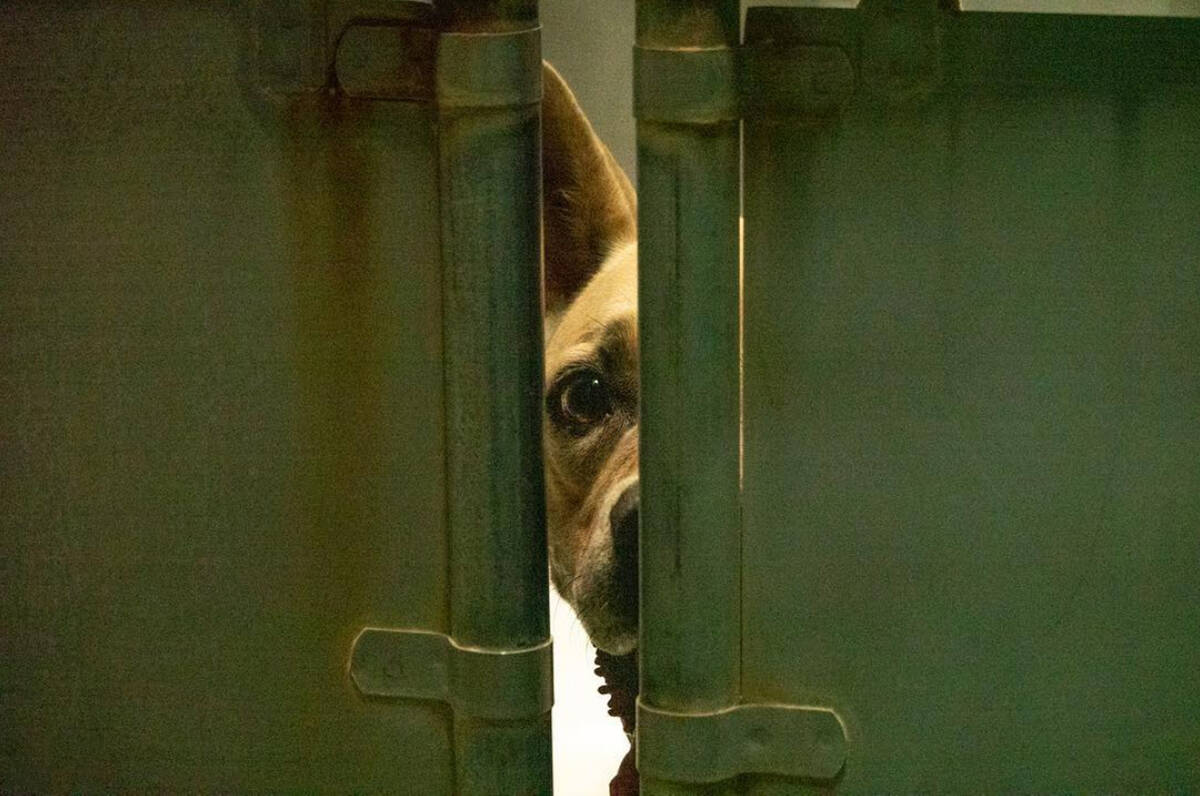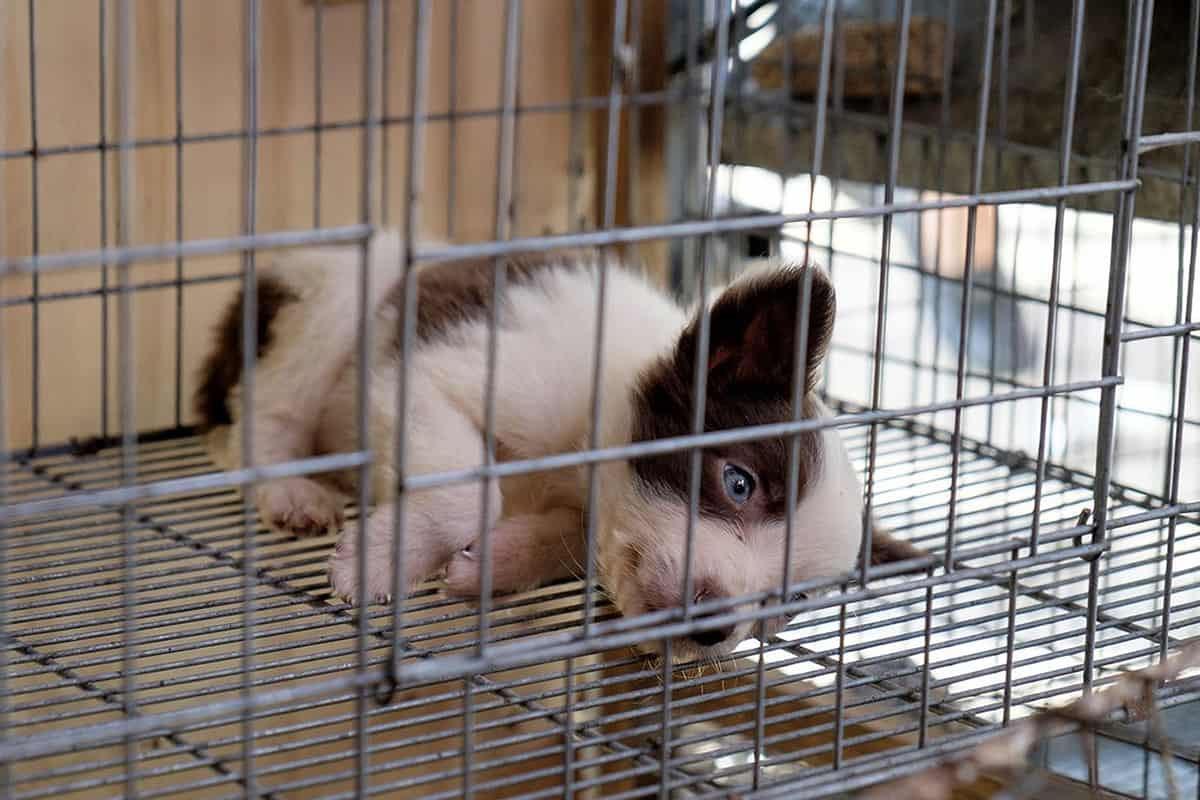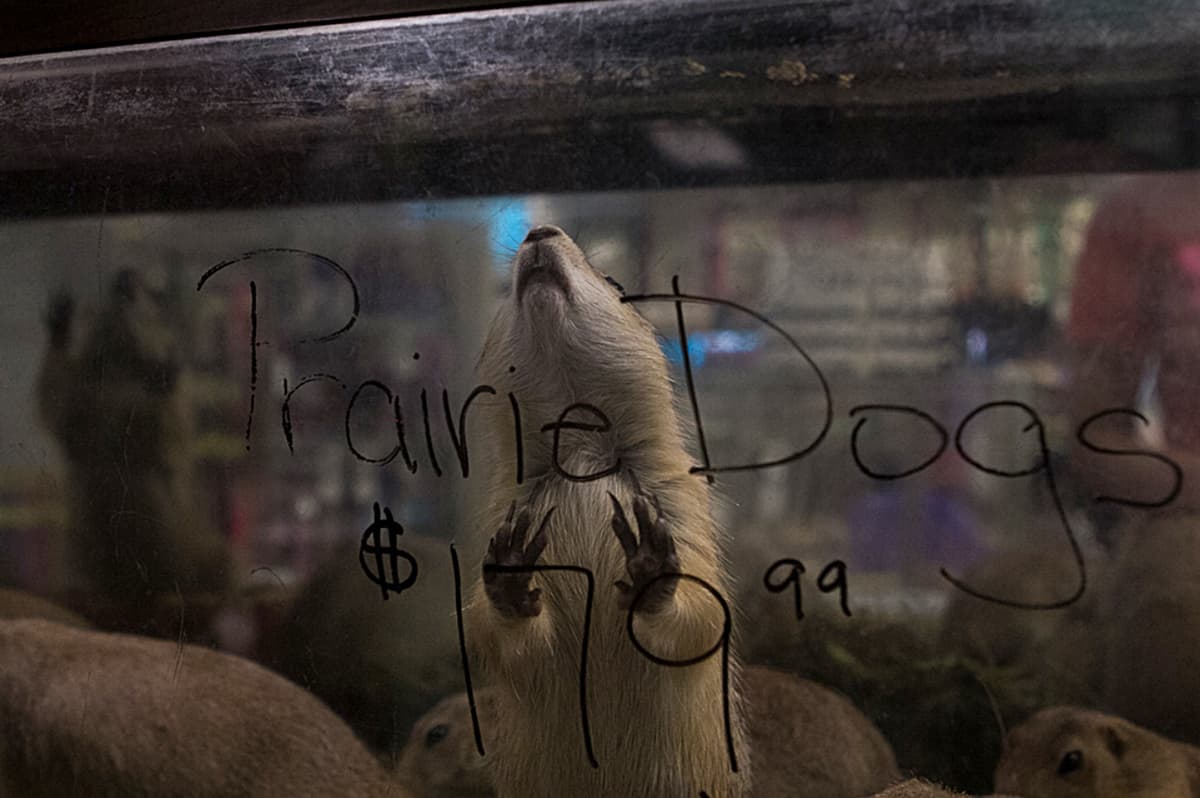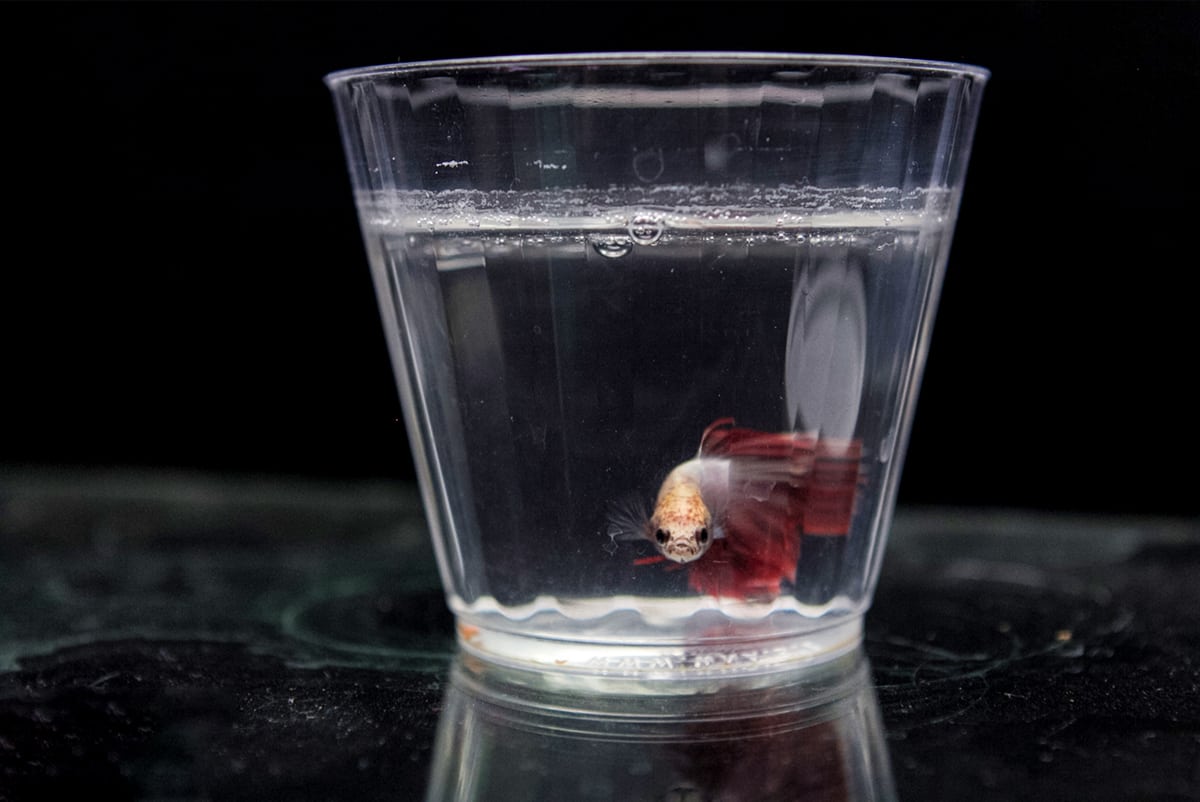Just like in every other arm of the animal trade, the pet industry regards our fellow animals as economic commodities to be mass-produced, warehoused, transported and sold like inanimate merchandise. Animals sold as pets end up with a 70% chance of being abandoned two years down the line, and every year, millions are killed in shelters.
Even in unusual cases where breeders take adequate care of both parents and offspring, the buyer off the street will dictate whether the individual purchased is treated well or is tortured, neglected, killed, or somewhere in between. Although rescue and adoption organizations (as well as some breeders) are more selective in rehoming than are pet stores, even many adopted animals will end up living a life of misery and neglect.
Regardless of who buys or adopts them, animals as pets are in a situation where their human owner controls (or, in some cases, tyrannizes) every aspect of their lives, including when and how often they eat, drink water, get exercise, or eliminate waste, whether they live indoors or out, or whether their environment is clean, filthy, foul, or disease-ridden. This inevitable reality, along with the fact that millions of innocent animals are killed in shelters annually, means that there is no such thing as “responsible breeding” regardless of how caring the breeder is toward the animals they control.
There are millions of animals annually up for adoption. If you are able to offer a safe and appropriate home to a nonhuman of any species, the only responsible decision is to rescue or adopt. Every time someone buys, a lonely and bewildered shelter animal dies.
In increasing numbers, animals bred to become our pets end up being sent to death only because most people think nothing of buying a ‘new’ puppy, or a ‘new’ kitten, rather than choosing to fill the space in their homes and hearts with someone to whom the opportunity represents nothing short of a second chance at life itself.
Shelter Deaths
In the US, according to many estimates, more than four million cats and dogs are killed in shelters every year. That’s a difficult figure to comprehend, but what it actually means is that more than 280 cats and 180 dogs are put to death every single hour of every single day. All the while, puppy mills alone breed an estimated two to four million dogs in the US every year.

Finding reliable statistics is difficult, because there are issues with accuracy in reporting. For worldwide numbers, it seems almost impossible to get accurate figures. It’s also difficult to find statistics that take into account the many other species killed every year in addition to cats and dogs, such as hamsters, gerbils, guinea pigs, fishes, and others who are also killed in increasing numbers. Rabbits, who are the third most popular animal used as pets, are also, not surprisingly, the third most frequently abandoned.
What many people don’t realize about animals in shelters is that they don’t all come from homes and families that can no longer care from them. Many are actually “unsold inventory” from pet stores, and in addition to those killed at the shelters, there are inestimable numbers of pet store rejects who end up being “disposed of” some other way. According to some sources, many end up being killed on site, or, possibly more frequently, they get returned to the breeder. In the case of animals from mills, this likely means they end up being killed at the mill, used for breeding, or sometimes even sold to vivisection labs.
Pet Stores
Every year, tens of thousands of baby animals are sold in pet stores, frequently after being shipped over several hundred miles, many of them seriously sick or even dying, after having been torn from their mothers when they are still infants.
In large pet stores, baby animals are frequently housed in rows of mesh-floored cages, sometimes with a hard floor tile, about 1 foot by 1 foot, which they are supposed to use as a bed. It is not uncommon for stores to be found violating a law that forbids floors with mesh wide enough to allow the feet of puppies and kittens to fall through, which often causes injuries.

Kittens, rabbits, parakeets, parrots, chinchillas, ferrets, hamsters, fishes, and a variety of others are also housed in cramped cages or aquariums and are sold with a minimum of instruction on how to properly care for them.
Investigations have linked large pet stores all over the U.S. to puppy mills and kitten farms; animal factories where individuals are used as breeding machines. Rabbit mills, bird mills, rat mills, hamster mills and guinea pig mills are all variations on the same sickening theme.
As factory farms are to the animals we use for food, breeding mills are to the animals we use as pets: horrific hells of extreme psychological and physical pain, neglect and deprivation. While it’s hard to find accurate numbers with regard to mills for other animals, there are an estimated 10,000 puppy mills in the United States (including both licensed and unlicensed facilities).
As with all cases where animals are being used for profit, laws provide little meaningful protection for these animals, so gross welfare offenses are common in these facilities, and despite increasing public awareness about the issue, investigations continue to uncover horrendous conditions, even as USDA inspectors frequently turn a blind eye to violations.
In April of 2019, months after California’s ban on puppy mills went into effect, undercover investigations found that pet stores were still selling puppies from mills, with the mills hiding behind phony shelter status in order to cover up the true nature of their operations.
Rodents
Pet stores are supplied with rodents by mass breeders, often placing mice, rats, hamsters and guinea pigs in cramped, cruel conditions that are not reflective of any natural environment.
Because breeding areas are often severely overpopulated, diseases and infections spread rapidly among rodents. Many captive-bred rodents live with chronic bacterial skin infections, respiratory illnesses and parasites.
As rodent sales represent only a modest profit for pet stores, they’re often treated as a very low priority for store owners. Many pet store rodents are kept in unsanitary conditions, fed sub-par food and suffer from chronic illnesses and conditions. Rodents purchased from a pet store have a high likelihood of dying soon afterward.

Small mammals such as rodents are often mistakenly thought to need very little attention, making them appear to be ideal companions for children, inexperienced animal caregivers, and even school classrooms.
In fact, rodents require regular, consistent social interaction with other members of their own species, and significant room to roam in order to stay happy and healthy. In addition, rodents are almost exclusively nocturnal. This means that during the day-time, they’ll want to hide and sleep. In noisy homes, they are unable to sleep when necessary, which disrupts their health. Many caged rodents may not sleep for days at a time, causing the onset of various neuroses.
Rodent teeth are also constantly growing. This means that rodents need plenty of objects to consistently chew on to help grind down their teeth as they grow. Without sufficient chewing, teeth can become impacted, resulting in a painful and potentially deadly infection. Most “owners” don’t see these signs or fail to act on them, leaving the animal to suffer.
Rodents are also especially susceptible to upper respiratory infections (URI). These infections are exceptionally painful, and require veterinary care immediately. Because rodents are so small, they often need a special small animal veterinarian. As these visits can quickly become costly, many owners forgo the cost, leading to prolonged suffering and early death.
Reptiles
Many reptiles commonly used as pets, like geckos and iguanas, are captive-bred before they’re sold to pet stores. In captive breeding arrangements, they’re kept in cramped, crowded and inhumane situations. These captive breeding centers facilitate the spread of disease, made worse by the propensity of reptiles to transmit pathogens.
Other reptiles are caught in the wild and illegally imported. This not only terrifies and psychologically scars the trapped individuals, it also wreaks havoc on the free-living populations decimated as a result. Transporting reptiles also devastates their health and immune systems, as temperature and humidity fluctuate wildly during the tremendously stressful journey.
Reptiles also require very specialized habitats. Being ectotherms, they need to derive enough heat and energy from their environment to survive. Heat and infrared lamps don’t provide the nourishment of natural sunlight, and without it, reptiles will become listless and sick. In addition, overhead heat lamps and heated rocks often prevent reptiles from finding the perfect range of heat they would obtain in nature, causing them to overheat. As a result, many become lethargic, depressed and debilitated in captivity.
Reptiles in pet stores often fade in color as they become depressed, malnourished and unwell. These ailing individuals are passed over by shoppers looking for exotic pets with bright colors and they are eventually abandoned outdoors, in a habitat ill-suited to support them. They generally die from exposure, malnutrition, or being eaten by predators.
Birds
The bird trade is a billion dollar industry worldwide, and in spite of escalating numbers of unwanted captive birds, the number bred increases annually. At the same time, cases of abuse and negligence continue to increase. Captive parrots, whose natural life span can be anywhere from 25 to 90 years, often die within five years, usually due to negligence or mistreatment.
All caged birds are either captured from the wild or bred in captivity. If a bird bred in captivity doesn’t sell before reaching the age of eight to ten weeks, she is often kept for breeding purposes. This means being confined to a small cage, and forcibly bred for the rest of her life.
Most commonly available birds are captive-bred. Exotic species are captured in their wild habitats and smuggled across borders in deplorable conditions. Only birds with “visual appeal” end up being owned as pets—most die in transit or are discarded when buyer interest wanes.
The Australian budgerigar is a type of parakeet often sold at big-box pet stores. Following cats and dogs, the budgerigar is the third-most commonly kept pet in the world. Its natural habitat is a far cry from life in a small cage. Budgerigars typically inhabit the wide-open grasslands and scrublands of the Australian Outback. Throughout the year, these birds will fly in small or large flocks, moving into open coastal forests as the conditions around them change.

The diet of wild budgerigars is diverse and varies throughout the year. Budgerigars feed on the seeds of spinifex, wild grasses and ripening wild wheat as they migrate, following rain patterns. There is no possible way to replicate this environment or feeding pattern. As a result, caged birds suffer from poor nutrition from food that lacks the natural nutrients they need to survive.
Many believe birds, particularly parakeets and parrots, make for ideal “starter pets,” because they’re confined to a cage. Tragically, the campaign has been successful to convince people, including apartment dwellers and senior citizens, that birds in cages make ideal companions.
Being prohibited from flying causes both physical and emotional health problems, and leaves birds depressed, anxious, and often neurotic. Additionally, many captive birds suffer from a range of health issues associated with a lifestyle that is so far from what nature intended.
In the wild, birds are flock-oriented, migratory animals. They depend on advanced social networks to survive, using highly developed evolutionary behaviors to navigate the world around them. They’re used to flying through diverse terrains, echoing ancient migration patterns. Caging a bird suppresses her nomadic tendencies, and deprives her of the rich social interactions that define her natural behavior.
Birds like the hugely popular African Grey can develop serious behavioral problems in captivity, such as destructive feather plucking. This self-mutilation can cause permanent damage, making it impossible for feathers to re-grow. The unbearable monotony of life in a cage leads some birds to develop a habit of screaming.
Many owners eventually give up on the responsibility altogether, and most abandoned birds will never find a home. Some spend the rest of their lives isolated and confined to cages in shelters and rescues, most of which are already over-burdened. An unknown number of unwanted birds are simply set loose, to face the dangers of the city, a world in which they have never learned how to survive.
Fishes
Most freshwater fishes for pet stores are bred in large farms, where they’re kept in plastic buckets. These breeding farms encourage the spread of disease, which can cause mass die-offs, or ill and weak fish populations. The small buckets also confuse and agitate the fishes, essentially leaving them to float stationary or in close proximity to others in the cramped quarters.
It’s nearly impossible to breed saltwater fishes in captivity. Because of this, as many as 90 percent of the saltwater fishes found in pet stores have actually been captured from their natural habitat. This practice is helping to drive many species to the brink of extinction. Many die from the shock of being plucked from one habitat and thrust into another that’s ill-equipped to support them.

Captive fishes are forced to swim around the same small container for their entire lifespans. They’re also unable to eat the rich, diverse diet they would normally be nourished by, and are robbed of the symbiotic relationships that they would naturally form.
In nature, fishes rely on highly intuitive relationships with each other, as well as plants, algae and other marine species. Some species of fish are migratory, traveling thousands of miles through lakes, rivers and oceans to return to breeding grounds. Others spend their entire lives in a small section of a single reef that is rich and diverse enough to fill all their needs.
Fishes communicate with one another using clicks, creaks and sighs that travel through the water. These sounds are used to form advanced social networks that fish rely on to feed, find mates and collaborate. Many work together with members of their own species, as well as other marine animals, in mutually beneficial partnerships. The sounds of tank filters and pumps interfere with these communication abilities, leaving fishes frustrated, disoriented and depressed.
Pet Fads
Pet stores, breeders and puppy mills all actively contribute to the major problem of pet fads or trends. While pushing certain breeds or species as particularly desirable, they breed and sell as many of them as possible before public sentiment moves on to the next trend.
From micro pigs to teacup dogs, pet fads are promoted by the industry whenever the market is perceived as needing a boost. Many of these fads are supported by celebrity trends and movie themes, which have driven pet crazes from turtles to chipmunks, ensuring that children send their parents in force to the pet stores to bring home these living birthday gifts.
In a society where small animals are generally viewed more as toys than sentient beings, it doesn’t take long before the latest cute commodity ends up discarded along with the millions of full-size dogs, cats, and other animals who are living on death row, after having committed no crime other than having worn out their welcome in a home where their novelty has faded.
Designer dogs
While the breed of dog currently en-vogue changes from year to year, nearly all designer dogs face the same fundamental problems. Many are bred using extremely selective techniques, leaving them with serious long-term health problems including poor immune systems, overextended spines, respiratory issues and more. Designer dogs often have very short lifespans compared with mixed breeds. Many require extensive medical attention throughout their lives and experience almost constant pain and discomfort.
Pygmy animals
Teacup pigs, pygmy goats and pygmy hedgehogs may look cute and quirky, but they suffer from many of the same genetic disorders facing designer dogs. It’s also impossible to adequately care for these animals in a home environment, leading to many of them dying prematurely or being abandoned.
Easter chicks and rabbits
Most are given as pets for children, who have no concept of how to handle or care for them, and lose interest quickly. As a result, many end up neglected or abandoned. Many people also dye chicks for Easter, which puts these young animals at a high risk for poisoning.
Rabbits are among the most frequently abandoned ‘companion animal’ in the US, partially because they’re so challenging to care for. Rabbits are naturally burrowing animals, and they require a cool, quiet and sheltered environment, which is virtually impossible to provide at home.
Color-dyeing
Many dyes—even those advertised as “pet safe”—are made with caustic chemicals that irritate skin and eyes. Dogs may try to lick the dye off, both during and following the dyeing process, irritating their stomachs or even poisoning themselves in the process. After dyeing, individuals may become depressed. Some dogs will refuse to go on a walk and others may lose interest in food and water. Dyes mask natural odors and appearance, which can cause other animals to act more aggressively toward the dyed animal.
Exotic species
Exotic pets come into the public eye every few years, usually following celebrity trends. Many of them, like reptiles, fishes, and birds, require large habitats and communities in which to survive and thrive. Almost every exotic animal is also the product of harmful breeding practices or horrific smuggling efforts. In either case, the animals’ lives are filled with fear, cruelty, and discomfort, as they are kept in habitats unsupportive of their unique needs.
The Exotic Pet Trade
The exotic animal trade falls behind only arms smuggling and the drug trade as the third-largest source of revenue for organized crime syndicates.
Many exotic animals are captured and trafficked using exceptionally cruel methods leading to, at the very least, long-term health problems. In many cases, trafficking ends in death for the animal. Because the trafficking of wild-caught exotic animals is ostensibly illegal, smugglers go to great lengths to transport those captured without being discovered. Many terrified individuals have their beaks tied and/or claws clipped, and are forced into cages that are far too small. They often arrive with post-traumatic stress, suffering from sickness or permanent injury. Many die during transit.
These complex beings are highly adapted to their natural environments. Many rely on extensive social communities to survive, and require very specific living conditions. Species from rainforests and jungles, for instance, need lots of densely covered space in which to hide. They also need high heat and humidity. Desert species, meanwhile, require lots of sand in which to burrow, as well as consistent heat and light. It’s simply impossible to replicate these environments adequately inside a home or in any captive situation.
The capture of exotic animals for use as pets is driving some species to the brink of extinction in their natural habitats. There are many that have seen their populations plummet due almost exclusively to illegal animal trafficking, including the Madagascar radiated tortoise and the African grey parrot.
The international smuggling of wild animals also contributes to the distribution of diseases that impact native species, people and farmed animals. In the 1970s, an outbreak of exotic Newcastle disease killed as many as 12 million birds in the United States. It was eventually traced back to parrots illegally smuggled from South America.